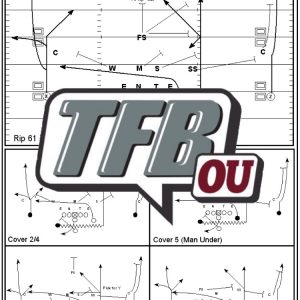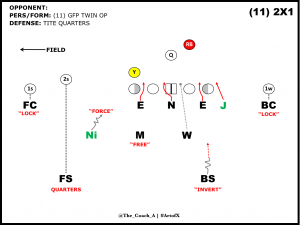 Alex Grinch | Defensive Identity | Part Four
Posted on: February 7, 2019
Alex Grinch | Defensive Identity | Part Four
Posted on: February 7, 2019
In an effort to provide our readers with as much insight into what Alex Grinch will bring to the table as the Sooners new Defensive Coordinator, we have brought in Cody Alexander to provide us with a multi-part in-depth series of notebooks. This is part three of the series.
Cody Alexander is currently the Secondary Coach at Midlothian HS (5A DII – TX) and author of MatchQuarters.com. He has written two books on defending modern offenses, Cautious Aggression: Defending Modern Football (2017) and Hybrids: The Making of a Modern Defense (2018).
Coach Alexander was the Defensive Graduate Assistant at Baylor University under former Arizona St. and Baylor Defensive Coordinator, Phil Bennett. During Coach’s tenure at Baylor, he assisted with the development of the corners and was placed in charge of opponent breakdowns.
Oklahoma Coverages
There is one overarching concept found within Grinch’s defense, aggression. The way everything is structured from the front to the backend is designed to pressure the offense, primarily the QB. Grinch’s uses pre-snap stemming to confuse the offensive line and marries it post-snap line movement. That’s essentially killing two birds with one stone.
The design behind Grinch’s run fits are the same. Suffocate the run with numbers and aggression towards the line of scrimmage. Though this may seem counterintuitive in the pass happy Big 12, the aggression actually creates predictable outcomes.
Grinch structures the secondary in the same manner as the front seven. There are multiple different ways Grinch can insert secondary players into the box to add numbers, or flood zones when it comes to the pass. The main objective is to ensure the box players can fly to the football.
There are five players within the secondary. This includes the Nickelback that aligns to the field. There are two trains of thought when comes to hybrid players. Teams like Texas and Georgia choose to play their Nickel to the passing strength and their hybrid DE away. Grinch keeps it simple by placing the Nickel to the field and his hybrid DE to the boundary. Though teams can attack the hybrid DE by placing formations into the boundary (FIB), Grinch can adjust with the Will LB or even rotate the secondary. Against tempo teams, this can be an asset.
In most modern defenses, the cornerback position has a field CB and a boundary CB. The boundary CB is your best man cover guy because he will most likely be in man situations, or at least situations with little help. This is the case in most 3×1 and 2×1 situations. The boundary safety in Grinch’s scheme is an add-in defender near the box and can function as the Nickel, but is better in coverage. Where Grinch gets unique is in the relationship between the field safety (FS) and the Nickelback. These players can be interchangeable, though the Nickel is a little sturdier. Below is an example of how Grinch can switch the FS and Ni during a given play.
Grinch bases out of a basic Quarters scheme. This allows Grinch to maximize the players near the box and adds to his manipulative nature. By staying in a two-high split-field alignment, Grinch can hide his intentions and manipulate the looks post-snap. This is done to confuse and pressure the QB into making wrong decisions based on a pre-snap read and it also inhibits the use of “freeze” plays where the offense uses a dummy cadence then looks to the sideline for an audibled call. Quarters is also similar to man, but safer because there is support. Below is a look at the base scheme used by Grinch versus an 11 personnel Y-off formation.

Grinch gets into an eight-man box by using the Nickel and BS as add-ins, or overhangs for the box. The Nickel to the field functions as the primary force player and can fold into the box if needed. If anything leaks out, he’s there to collect it. The FS plays overtop the slot WR with the expectation the Nickel will help him late. To the boundary, the BS is what I refer to as the “capper.” He is the trash man, and plus-one fitter to the weak side of the box. He will correct any mistake the Will makes and will be there to vice the run. The both CBs are essentially in man coverage, but their pressed alignment makes the throws predictable (Fades/Slants) and low percentage. The BS versus the pass will help the CB underneath or can cut through the middle of the field (MOF) to support any over route. Here is a look at a basic fit versus a Y-off formation.
To change things up to the front side, Grinch can lock the Nickel on the slot and let the FS come down to fit in the alley. This is a clever way to keep the QB from throwing screens (RPOs) because the Nickel is in a full cover down (he’s moved all the way out to the slot). In the clip below, the BS will run his typical technique and insert as the capper. The FS is now afforded to attack the line of scrimmage (LOS) because the Ni has the slot in man. Though the interior lineman made the play, you can see how the Ni took the Bubble and the FS sunk into the box. Regardless, the run was going to be stopped near the LOS.
How this style of play functions can be seen in this next clip. Grinch is essentially playing man coverage, with support underneath. Offenses can use this to attack the weaker match-ups. The clip below shows a Slot Fade by the #2 WR. This is a direct target on the Nickel and his coverage abilities. The full cover down by the Ni tips the offense off that he will be in man. At the snap of the ball, the FS inserts into the alley and the Ni is left to defend the slot on his own. This is why, in Grinch’s defense, the Ni and the FS have to be interchangeable. Oklahoma will essentially be playing with three-safeties, all of which need to be able to cover. Finally, notice the BS turn and work through the MOF. This is because he is reading the eyes of the QB, which are clearly to the front side of the play.
Teams that base out of true Quarters need to have the ability to roll strong to counteract the aggressive nature of their Ni. Offenses that see a lot of Quarters understand that in order to beat the defense in the pass, you either have to take shots (low percentage) or attack the soft outside area. To counter this, Quarters teams use a strong roll illustrated below. This baits the offense into throwing to the slot on an out cut.
Pre-snap, the Nickel creeps near the box to give the illusion of either over aggression or a blitz. The FS will jump to outside alignment and rob any outside cut by the slot. The Nickel walls the inside. To the backside, the BS will work immediately to the MOF reading the QB. His role is to cut off the Post from either side of the box. As stated in prior coverages, the CBs are essentially in man-to-man scenarios.
Versus 3×1 formations, Grinch can be just as multiple. Against 10 pers. looks, Grinch can play split-field or “poach” the backside safety. One of the main coverages Grinch uses versus 10 pers. 3×1 sets is what is referred to as Stump. This places the CB to the Trips side in pseudo-man coverage. What is referred to as MOD, or man-on-demand. In this type of coverage, the CB will only take the #1 WR if he goes out or up. If the WR goes back into the MOF, he releases him and works to the next man, usually #2. This allows the boundary safety to stay to the backside for run support, or to help the CB over the “X” WR (single-WR).
In the clip below, Colorado attacks the defense with a Bubble by the #3 WR. This is what Stump is designed to stop. Over top the #2 and #3 WRs are the Nickel and FS. They are playing what is referred to as 2-Read. The Mike is going to hold the curl to the inside. The defense creates a triangle overtop the two inside WRs. The CB is aligned off of #1. As the play develops, the CB’s depth allows him to fold in. The Ni quickly darts on ball thrown and tackles the #3 WR. The FS and CB rally to the ball.
The split-field scheme found in Stump coverage affords Grinch the ability to sink the backside safety into the box. This relieves the conflict of the Mike so he can vacate the box and take the #3 WR. Offenses like to attack a defense by running simple stop routes with #3. This alignment takes that away.
If Grinch wants to go away from a two-high shell, he can “poach” the backside safety. Poach refers to the backside safety. He is reading the #3 WR’s departure. If #3 goes vertical, the safety will work over top. The Mike will work underneath #3. The front side will create a three-over-two matchup with the #1 and #2 WRs. Below is a clip of this type of coverage.
Pre-snap, the safeties appear to be in a split-field look, but at the snap of the ball, the backside safety works to the MOF anticipating a vertical by #3. As #2 runs an under route, the FS then relates to his new #2, the #3 WR running a Corner route. As the #3 WR bends back outside, the BS stays in the MOF reading the QB. The Will LB takes the RB man-to-man as he flares and the Mike picks up the under route by #2 along with the Ni. The result is an incomplete pass.
Grinch matches the aggression up front with aggression in the backend as well. Though he is not running true “zero” coverage where the secondary is completely in man, Grinch uses Quarters and subtle tweaks to coverage to counter what the offense is running. The modern defense has to be able to adjust to a multitude of looks any given week. The ability for the secondary to support the front seven is crucial and Grinch does a great job of changing up the looks and support players. Hybrids are the key in his defense and the Ni, FS, and BS all have to be able to play coverage and near the box. With his experience in the PAC-12, Grinch should have a solid plan for dealing with the high powered offenses found within the Big 12.

